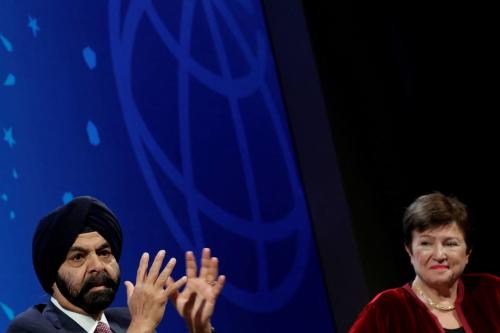Editor’s note: This piece is translated and adapted from Domenico Lombardi’s bimonthly column “Pennsylvania Avenue” in the Italian daily Il Foglio.
Today’s meeting between Greek Prime Minister Antonis Samaras and European Central Bank President Mario Draghi is a further sign of the increasingly important role of the Eurotower in dealing with the crisis in Europe. Leveraging on the ECB’s announcement last week of a bond-buying program to stabilize financial markets in Europe, Prime Minister Samaras will likely ask that the ECB apply a similar criterion for the Greek bonds in its portfolio by giving up its privileged creditor status.
A favorable response would pave the way for a new restructuring of the Greek debt now held almost exclusively by the official sector. Such restructuring represents, in the medium term, one of the conditions necessary to jump-start the economy and, in the short term, would encourage a re-engagement of the International Monetary Fund in Greece. In fact, the IMF is bound to fund “sustainable policies” in any borrowing country and the current outlook in Greece—with GDP in freefall and the debt-to-GDP ratio skyrocketing—looks anything but sustainable.
While today’s meeting may not have any concrete resolutions, the bond purchasing plan announced by the ECB last week may have important implications for Italy—the third largest eurozone economy with a public debt worth €2 trillion or 5 percent of the global bond market. In fact, the institutional framework that has been set up for the new ECB bond-buying program, or as it is officially called the Outright Monetary Transactions (OMT) program, is new and unprecedented. However, the framework’s apparent complexities mask some potentially problematic aspects of the program.
First, the purchase of short-term bonds alone risks creating problems for the management of Italy’s public debt. One of the reasons why the country was able to resist escalating speculative pressures is because of the relatively high duration of its debt, which hovers at about seven years. Thus, an OMT program for Italy, which may be quite protracted if ever activated, will reduce that duration since new issuances will be primarily in the form of shorter-term bonds purchasable by the ECB. Notably, the choice of the ECB goes in the opposite direction of the approach adopted by the U.S. Federal Reserve, which has favored the purchase of longer-term bonds through the recent “Operation Twist”.
For a country with high debt like Italy, the purchase of longer-term bonds by the ECB would not significantly affect the incentive to fulfill its agreed-upon commitment. If Italy were to renege on its commitments, then the ECB would put an end to its purchases and the spreads would instantly climb, taking the bond yields to considerably higher levels. Given the enormous amount of debt to refinance, the incentive to follow through would be significant in any case.
In contrast, under the current setup, since the program would last for quite some time, the debt duration would be reduced, paradoxically creating a condition of greater vulnerability to future speculative attacks. This prospect would make Italy more and more dependent on forms of supranational assistance and on countries like Germany which have heavy influence over institutions like the ECB.
As for the role of the European Financial Stability Facility (EFSF), it can purchase only up to half of the bond issuances in the primary market under the current guidelines. In the case of Italy, this limit is purely theoretical. In fact, the fund has available—net of existing obligations— €150 billion in its coffers, which would barely cover half of the primary net issuances that the Italian Treasury carries out, on average, in any given year. And this is based on the highly unrealistic assumption that no other eurozone country would request help from the fund.
Really the EFSF’s role is to introduce the requirement whereby beneficiary countries must agree to a program of formal policy conditions and therefore help the ECB avoid the serious embarrassment of imposing on its member countries conditionality. And yet, the EFSF does not have the in-house skills to design and monitor stabilization programs.
For this reason, the OMT framework foresees the intervention of the IMF to design the program conditions and to verify their implementation by the beneficiary country. The question is: what kind of conditionality will the IMF introduce? Based on the programs already in existence in the eurozone, it is likely to cover structural and competitiveness policies.
In the case of Italy, it is difficult to imagine fiscal conditionality beyond any of the obligations already taken by the Monti government. Moreover, the enforcement of fiscal policy falls under the Fiscal Compact Treaty and the broader EU legal framework. However, the presence of the IMF would be helpful. On the one hand, it would alleviate the problem of the scarce financial resources of the EFSF and offer a less embarrassing way to apply to IMF financing in the context of what is officially a tripartite program led by EU institutions. On the other hand, it would offer an exit strategy to the ECB, whereby once bond purchases were ended through mutual consent, the country in question would spend a post-program period of “convalescence” monitored by the IMF.
It is not clear yet if and when the Italian authorities will request assistance under the newly-established OMT program. For the time being, their plan is to benefit for as long as possible from the dampening effect on yields that have resulted from the simple announcement of the new program.



Commentary
Op-edThe European Central Bank’s New Bond-Buying Program: Implications for Italy
September 11, 2012